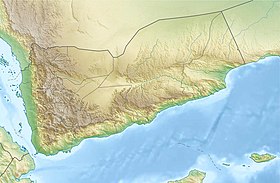al-Ḥuqqa
al-Ḥuqqa in what is now Yemen |
Al-Ḥuqqa ( old South Arabic Dmhn ) is an archaeological site from the Sabaean epoch in the Yemeni highland basin .
geography
Al-Ḥuqqa is located in the south of the ʿAmrān governorate , on the route from Sanaa northeast to ʿAmrān . The site is to the east of this route, about 10 kilometers as the crow flies from another ancient site of this time, Ḥāz .
history
The history of the place has not been adequately researched. According to sources, al-Ḥuqqa, which is located in the central mountainous region of Yemen, is said to have belonged to the Gau Ḥumlān, part of the kingdom of Sum'ay . The predominant clan were the Banū Bataʿ .
In 1928 Carl August Rathjens and Hermann von Wissmann mined in al-Ḥuqqa under the direction of Yahya Muhammad Hamid ad-Din. A filled-in temple could be brought to daylight. The researchers found that the temple and other ruins in the area (such as Hamdān and Arḥab ) must have been built at the latest by the time of Wahb-il Yahuz (around 90 AD). One of the inscriptions from al-Ḥuqqa (cited as RES 4013) names a certain Sa'dta'lab Yuhaṯib, who is also epigraphically immortalized in connection with another complex . The two researchers also found similarities between this Sabaean find and the pillar mosques of early Islam , the forerunners of which the temple can be considered. However, they did not express an opinion on this, but merely stated that the temple belonged to a single construction period.
The temple in al-Ḥuqqa was dedicated to the sun goddess Ḏat Baʿadān (winter sun) . Architecturally, it followed the basic principle of a rectangular courtyard surrounded by pillars with an axially arranged entrance and a propylon in front , similar to the temples of Qarnawu and Sirwah . A three-sided gallery of columns lines the staircase to the sanctuary in the courtyard of the complex . Inside the enclosure wall and to the right of the entrance is a temple cistern (tub cistern ) which is covered by the access area .
see also article section: Architectural history of South Arabia
literature
- Horst Kopp (Ed.): Geography of Yemen . Dr. Ludwig Reichert Verlag Wiesbaden, 2005, ISBN 3-89500-500-2 .
- Hermann von Wissmann : On the history and regional studies of old South Arabia. ( Eduard Glaser Collection , No. III = Austrian Academy of Sciences, Philosophical-Historical Class, Meeting Reports, Volume 246) Böhlaus, Vienna 1964.
- Adolf Grohmann : Handbook of ancient studies. Cultural history of the ancient Orient. Third section. Fourth subsection: Arabia . Munich 1963 (comprehensive cultural history of pre-Islamic Arabia, which is out of date in some areas due to the results of recent excavations).
- Jürgen Schmidt : Old South Arabian cult buildings . In: Werner Daum (Ed.): Yemen . Pinguin-Verlag, Innsbruck / Umschau-Verlag, Frankfurt a. M. 1987, pp. 81-101, ISBN 3-7016-2251-5 .
- Hermann von Wissmann: On the archeology and ancient geography of South Arabia , subtitles: Ḥaḍramaut, Qatabān and the ʿAden area in antiquity , Istanbul / Leiden 1968.
Individual evidence
- ↑ Old South Arabic spelling according to DASI
- ↑ cf. Horst Kopp (Ed.): Geography of Yemen . Dr. Ludwig Reichert Verlag Wiesbaden, 2005, ISBN 3-89500-500-2 .2005, pp. 30, 37; see also the listing of the place of discovery in the map enclosed there
- ^ A b Hermann von Wissmann : On the history and regional studies of old South Arabia. (Eduard Glaser Collection, No. III = Austrian Academy of Sciences, Philosophical-Historical Class, Meeting Reports, Volume 246) Böhlaus, Vienna 1964, pp. 324, 332.
- ^ Hermann von Wissmann, Maria Höfner : Contributions to the historical geography of pre-Islamic South Arabia (= Academy of Sciences and Literature Mainz, treatises of the humanities and social sciences class. 1952, issue 1–5). Wiesbaden / Mainz 1952, p. 20.
- ↑ Hermann von Wissmann, On the archeology and ancient geography of South Arabia, p. 53
- ↑ Hermann von Wissmann points out in a footnote that the inscriptions of al-Ḥuqqa paleographically refer to a time that begins with Wahb-il Yahuz and only extends to this period and refers to his work, Zur Geschichte und Landeskunde von Old South Arabia .
- ↑ a b Adolf Grohmann: Handbook of ancient science. Cultural history of the ancient Orient. Third section. Fourth subsection: Arabia . Munich 1963 pp. 140 ff. (With illustrations); Views: 1.) Floor plan / 2.) Temple model.
- ↑ Jürgen Schmidt : Old South Arabian cult buildings . In: Werner Daum (Ed.): Yemen . Pinguin-Verlag, Innsbruck / Umschau-Verlag, Frankfurt a. M. 1987, pp. 81-101, ISBN 3-7016-2251-5 , p. 85.
Coordinates: 15 ° 34 ′ 49 ″ N , 44 ° 4 ′ 12 ″ E
